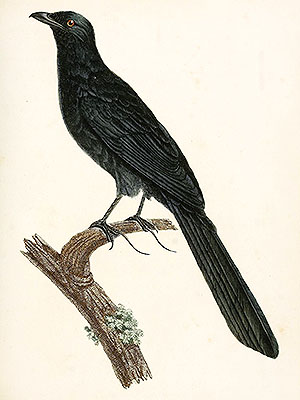This is another of the enigmatic birds that were described and depicted by François Le Vaillant at the very beginning of the 19th century.
The bird is supposed to originate from South Africa, and it appears to be known from at least five actual specimens, three males and two females, that were collected (hunted and killed) by François Le Vaillant himself.
„Cjet oiseau qu’on reconnoîtra facilement à tous ses caractères pour appartenir au genre coucal, habite le pays des Caffres et ne fréquente que les grandes forêts. Il se perche sur les branches basses des arbres, d’où le mâle fait entendre d’une voix plaintive les deux syllabes côoo-ro répétées jusqu’à dix fois de suite, et toujours sur le même ton. On le trouve presque toujours avec sa femelle. Celle-ci, comme toutes les femelles d’oiseaux chanteurs, ne chante pas non plus; mais elle a un cri précipité cri-cri-cri-cri’, qui a beaucoup de rapport avec celui que fait notre émérillon lorsqu’il plane dans les airs , et qui paroît être le cri d’appel, car le mâle le faisoit aussi lorsqu’il vouloit avoir sa femelle auprès de lui, comme lorsqu’il paroissoit craindre de se trouver dans quelque danger: toutes les fois du moins qu’il s’appercevoit que j’essayois de l’ap- procher, il se tenoit sur ses gardes, et il répétoit ce même cri jusqu’à ce que j’eusse disparu à ses yeux, et que sa fe- melle l’eût rejoint. C’est aussi dans un creux d’arbre que le Coucal nègre fait sa nichée. La femelle pond quatre œufs d’un blanc de craie, et que le mâle et elle couvent tour-à-tour.“
Translation:
„This bird, which is easily recognized by all its characters to belong to the coucal genus [Centropus], inhabits the country of the Caffres and frequents only the great forests. It perches on the lower branches of the trees, whence the male utters in a plaintive voice the two syllables of the same color, repeated ten times afterwards, and always on the head. One finds himself almost always with his female. The latter, like all the females of birds of prey, do not excite more; but that is a precipitate cree-cree-cree-cree, which has much to do with that which our merlin [Falco columbarius] does when it hovers in the air, and which appears to be the cry of appeal, for the male also did it when he wished to have his female near him, as when he appeared to be afraid of finding himself in some danger: whenever he perceived that I was trying to approach him, he was on his guard, and he repeated the same cry until I had disappeared from his eyes, and his wife had rejoined him. It is also in a hollow of tree that the Negro Coucal makes its brood. The female lays four eggs in a chalk white, and the male and she hatch in turn.“
***
The description tells us that this bird was completely black.:
„Le Coucal nègre a le corps de la grosseur de celui de notre grive draine. Sa queue légèrement étagée, est de la longueur de tout son corps, y compris la tête et le cou. Le bec, les pieds et tout le plumage de cet oiseau sont d’un noir mat, sans teinte d’aucune autre couleur absolument. Les yeux sont marron foncé. La femelle est un peu plus petite que le mâle, et son noir brunit un peu sur le ventre.“
Translation:
„The Negro Coucal has the body of the size of that of our mistle thrush [Turdus viscivorus]. His slightly stepped tail, is the length of his whole body, including the head and neck. The beak, the feet and all the plumage of this bird are of a matt black, without shade of any other color absolutely. The eyes are dark brown. The female is a little smaller than the male, and her black browns a little on the belly.“
There are indeed some all-black or more or less completely black coucal species known to exist, these are the Black-billed Coucal (Centropus bernsteini), the Biak Coucal (Centropus chalybeus), the Green-billed Coucal (Centropus chlororhynchus), the Ivory-billed Coucal (Centropus menbecki), the Kei Coucal (Centropus spilopterus), the Black-hooded Coucal (Centropus steerii), the Violaceous Coucal (Centropus violaceus), and a subspecies of the Philippine Coucal (Centropus viridis ssp. mindorensis), yet none of them inhabits Africa.
***
The last part oft he original text tells us a bit about the habits and the food oft hat birds.:
„Je n’ai tué que cinq individus de l’espèce, trois mâles et deux femelles: je n’en ai pas vu les jeunes, les petits n’étant pas encore éclos lorsque je quittai le canton où j’ai trouvé l’espèce. A la dissection, je n’ai trouvé que des débris d’insectes dans le corps de ces oiseaux.“
Translation:
„I killed only five individuals of the species, three males and two females: I did not see the young, the young ones not having hatched yet when I left the canton where I found the species. At the dissection, I found only debris of insects in the bodies of these birds.“
So, obviously the author found the birds by himself in the named place, at least five specimens were taken (where are they today?), so this Black Coucal very likely actually existed, but what is/was it? A now extinct species, a subspecies of another species, a color morph?
We may never find out.
*********************
[1] François Le Vaillant: Histoire naturelle des oiseaux d’Afrique. Paris, Delachaussée, Rue du temple, N°. 40. Vol. 5. 1806
*********************

(not in copyright)
*********************
edited: 11.11.2018
